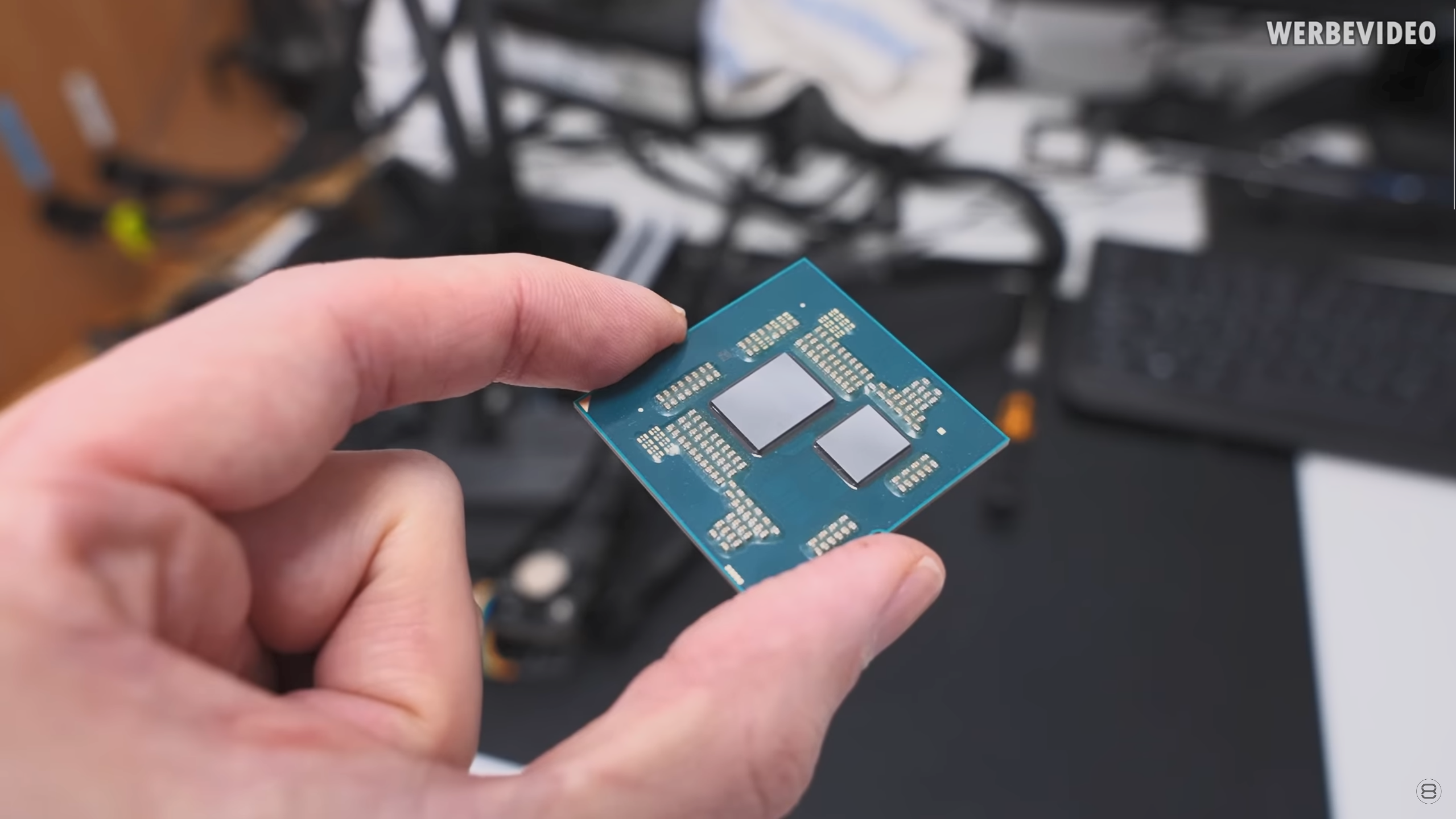The ultra-rare Ryzen 7 9800X3D now available delidded for $599 with two-year warranty

Thermal Grizzly is now offering delidded AMD Ryzen 7 9800X3D, one of the best CPUs, with a two-year warranty for $599 (without VAT), which is quite an impressive price tag since you get to enjoy the perks of a delidded CPU without the risk and labor. Der8auer, also known as Roman and Thermal Grizzly's CEO, posted a video on YouTube detailing the entire procedure, including logistics, the delidding process, and pricing rationale.
Removing your CPU's IHS (Integrated Heat Spreader) is known as delidding. The IHS absorbs the heat produced by your CPU's die and transfers it to the heat sink. Several strategies can be employed to get the most out of your CPU, such as replacing the sTIM or thermal paste with liquid metal or opting for direct-die cooling. Of course, nothing's perfect; CPU delidding carries the risk of cracking the die and almost certainly voids your warranty if you need it.
Thermal Grizzly offers a solution for mainstream customers. Essentially, you'll be greeted by a delidded Ryzen 7 9800X3D alongside its IHS without getting your hands dirty for a slight markup versus MSRP. The base price set by Thermal Grizzly is $599 (without VAT) or roughly $699 (with VAT) for European customers.
The CPUs are sourced from German retailer Mindfactory, delidded in-house, tested, and shipped to you. The extra $100 you pay over MSRP constitutes the service fee and warranty insurance. Roman says the warranty covers all sorts of damage except for mechanical damage, which may be caused by improperly mounting the CPU.

The process involves unpacking the CPUs and sliding them into delidding tools, like the Delid Die Mate. Afterward, the CPUs undergo a two-phase heating procedure in an oven, arranged like cookies in a tray. Each of these trays (with the CPUs) can cost up to $10,000, and the processors are heated at 160-170 degrees Celsius until the IHS gradually comes off. The next step involves testing and validation to verify functionality and record temperatures.
The packaging features a small box from Thermal Grizzly containing the original AMD packaging, the delidded CPU, the IHS, and a USB stick with additional information, such as expected temperatures and close-up shots of your CPU. You can grab a unit for yourself at Thermal Grizzly's website. Note that the price on the landing page may include the VAT and, therefore, be higher.
Get Tom's Hardware's best news and in-depth reviews, straight to your inbox.

Hassam Nasir is a die-hard hardware enthusiast with years of experience as a tech editor and writer, focusing on detailed CPU comparisons and general hardware news. When he’s not working, you’ll find him bending tubes for his ever-evolving custom water-loop gaming rig or benchmarking the latest CPUs and GPUs just for fun.
-
Gururu His video on this was really interesting. Warranty seems a little risky for them with only a $100 price bump, but it seems like a great service.Reply -
Notton If it's only a $100 premium, it seems well worth it.Reply
That is assuming you know how to reinstall the heat spreader.
Way better than forking over extra to a scalper. -
Misgar After spending years working in Aerospace Industry labs with full ESD protection, I was disappointed to see what seems to be a total lack of "correct" handling procedures at 6 minutes into der8auer's video, when the CPUs are removed from the AMD cartons and placed in the de-lidders.Reply
Similarly, I doubt if the heat protective gloves used after heating the CPUs to 170°C are ESD approved gloves.
Perhaps some of Tom's readers are similarly unconcerned about the risk of ESD damage when handling CPUs and RAM, but I for one will not be buying a de-lidded CPU. I'd rather do it myself and risk breaking it.
ESD damage is insidious and can appear months or years after the original static discharge, caused by poor handling technique. If your de-lidded CPU dies after the 2 year der8auer warranty expires, you're on your own.
Mind you, a dead 9800X3D is unlikely to be a life threatening event, unlike several critical aircraft control system failures at 33,000ft, so perhaps it doesn't matter if your gaming PC dies.:( -
aberkae The 9800x3d is already a great cpu, my 9800x3d with msi tomahawk x870e and lianli GA 2 trinity 360 mm rad hovers below 50 degrees celcius during gaming. @ 5.425 ghz.Reply -
drivinfast247 ReplyMisgar said:After spending years working in Aerospace Industry labs with full ESD protection, I was disappointed to see what seems to be a total lack of "correct" handling procedures at 6 minutes into der8auer's video, when the CPUs are removed from the AMD cartons and placed in the de-lidders.
Similarly, I doubt if the heat protective gloves used after heating the CPUs to 170°C are ESD approved gloves.
Perhaps some of Tom's readers are similarly unconcerned about the risk of ESD damage when handling CPUs and RAM, but I for one will not be buying a de-lidded CPU. I'd rather do it myself and risk breaking it.
ESD damage is insidious and can appear months or years after the original static discharge, caused by poor handling technique. If your de-lidded CPU dies after the 2 year der8auer warranty expires, you're on your own.
Mind you, a dead 9800X3D is unlikely to be a life threatening event, unlike several critical aircraft control system failures at 33,000ft, so perhaps it doesn't matter if your gaming PC dies.:(
And if you break your CPU while delidding, you have a trashed CPU that you never even got a chance to use. -
Amdlova Trying for years to get some hardware dead with esd. I just don't use any plastic cloth and aways have my feet on the ground.Reply
My body always are discharged if miss something, I will be electrocuted =) -
GoldenGonchies It's such an easy to cool CPU already, I haven't managed to get a hot spot over 65C with even the toughest benchmark loads. Is the delidding meant for heavy overclocks or something?Reply
FWIW this processor is fully instock at every online retailer in Canada and has been for weeks. Do they not ship to the US? -
Gururu Reply
Ruh-Roh, I hold my CPUs with bare hand too, so I guess he isn't doing anything different that I would do. They seem to be using Strong leather construction gloves also when taking the chips out of the oven. On both accounts, I agree its pretty sloppy.Misgar said:After spending years working in Aerospace Industry labs with full ESD protection, I was disappointed to see what seems to be a total lack of "correct" handling procedures at 6 minutes into der8auer's video, when the CPUs are removed from the AMD cartons and placed in the de-lidders.
Similarly, I doubt if the heat protective gloves used after heating the CPUs to 170°C are ESD approved gloves.
Perhaps some of Tom's readers are similarly unconcerned about the risk of ESD damage when handling CPUs and RAM, but I for one will not be buying a de-lidded CPU. I'd rather do it myself and risk breaking it.
ESD damage is insidious and can appear months or years after the original static discharge, caused by poor handling technique. If your de-lidded CPU dies after the 2 year der8auer warranty expires, you're on your own.
Mind you, a dead 9800X3D is unlikely to be a life threatening event, unlike several critical aircraft control system failures at 33,000ft, so perhaps it doesn't matter if your gaming PC dies.:( -
MergleBergle Question, is the 9800x3D still ultra-rare as mentioned in the title? One of the biggest retailers in Canada has had it constantly in stock for weeks now.Reply
